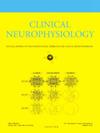Changes in the thalamocortical component of high frequency oscillations following botulinum toxin treatment in cervical dystonia
IF 3.6
3区 医学
Q1 CLINICAL NEUROLOGY
引用次数: 0
Abstract
Objective
This study aims to investigate the central effects of Botulinum toxin type A (BoNT-A) on the somatosensory system in patients with cervical dystonia (CD), focusing on the thalamocortical pathway using high-frequency oscillations (HFOs) and short-latency afferent inhibition (SAI).
Methods
An observational longitudinal study was conducted on 10CD patients and 10 healthy controls (HC). HFOs and SAI were assessed for CD and HC at baseline (T0; the day before BoNT-A treatment). Then only for CD patients, SAI and HFOs were assessed again 30 days after (T1) BoNT-A treatment. Changes in SAI values and HFO early and late area between T0 and T1 in CD patients were evaluated with the Wilcoxon signed-rank test.
Results
At T0, CD patients exhibited significantly reduced early HFOs compared to HC, with no significant differences in late HFOs or SAI values. After BoNT-A treatment, a significant increase in early HFOs was observed in CD patients at T1, while late HFOs and SAI values remained unchanged.
Conclusion
The findings suggest that BoNT-A treatment may have central effects on thalamocortical activity, as evidenced by changes of early HFOs in CD patients following injections.
Significance
This study provides neurophysiological evidence supporting the central effects of BoNT-A on the somatosensory system and corroborates the idea of a somatosensory involvement in CD pathogenesis. This funding could pave the way for future integrated treatment approaches.
肉毒杆菌毒素治疗后颈肌张力障碍丘脑皮层高频振荡成分的变化。
目的:本研究旨在探讨A型肉毒毒素(BoNT-A)对颈肌张力障碍(CD)患者体感觉系统的中枢作用,重点是通过高频振荡(HFOs)和短潜伏期传入抑制(SAI)研究丘脑皮质通路。方法:对10例cd患者和10例健康对照进行观察性纵向研究。在基线时评估hfo和SAI的CD和HC (T0;BoNT-A治疗前一天)。然后仅对CD患者,在(T1) BoNT-A治疗后30天再次评估SAI和hfo。采用Wilcoxon sign -rank检验评价CD患者T0 ~ T1间SAI值和HFO早、晚区域的变化。结果:在T0时,与HC相比,CD患者早期HFOs明显减少,晚期HFOs或SAI值无显著差异。经BoNT-A治疗后,T1时CD患者早期hfo显著增加,而晚期hfo和SAI值保持不变。结论:研究结果表明BoNT-A治疗可能对丘脑皮质活性有中心作用,正如注射后CD患者早期hfo的变化所证明的那样。意义:本研究提供了神经生理学证据,支持BoNT-A对体感觉系统的中枢作用,并证实了体感觉参与CD发病机制的观点。这笔资金可以为未来的综合治疗方法铺平道路。
本文章由计算机程序翻译,如有差异,请以英文原文为准。
求助全文
约1分钟内获得全文
求助全文
来源期刊

Clinical Neurophysiology
医学-临床神经学
CiteScore
8.70
自引率
6.40%
发文量
932
审稿时长
59 days
期刊介绍:
As of January 1999, The journal Electroencephalography and Clinical Neurophysiology, and its two sections Electromyography and Motor Control and Evoked Potentials have amalgamated to become this journal - Clinical Neurophysiology.
Clinical Neurophysiology is the official journal of the International Federation of Clinical Neurophysiology, the Brazilian Society of Clinical Neurophysiology, the Czech Society of Clinical Neurophysiology, the Italian Clinical Neurophysiology Society and the International Society of Intraoperative Neurophysiology.The journal is dedicated to fostering research and disseminating information on all aspects of both normal and abnormal functioning of the nervous system. The key aim of the publication is to disseminate scholarly reports on the pathophysiology underlying diseases of the central and peripheral nervous system of human patients. Clinical trials that use neurophysiological measures to document change are encouraged, as are manuscripts reporting data on integrated neuroimaging of central nervous function including, but not limited to, functional MRI, MEG, EEG, PET and other neuroimaging modalities.
 求助内容:
求助内容: 应助结果提醒方式:
应助结果提醒方式:


